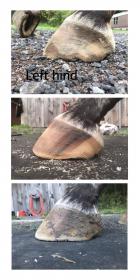Great news on the diagnosis! So much better to know what you’re working with and make a plan.
I am not a “barefoot uber alles” person, and I am also not a vet or a farrier. I am literally just a stranger on the internet so these thoughts are worth what you paid for 'em .
That being said, I’d really hesitate to go that shoeing route as the first step.
Thin soles are rarely improved by putting on a shoe - or in the case of an already shod horse, changing the type of shoe. They can almost always be improved by balancing diet and by allowing the sole to actually work - i.e. be stimulated by pressure via movement. Boots with pads for turnout, riding, or both - depending on level of comfort on various surfaces - are, in my experience, the best place to start.
A ditto with the hinds and the wedge pads. I’ll echo @BoyleHeightsKid’s recommendation to understand what is causing the NPA in the hinds. Underrun heels and a long toe are the culprit in almost every case I personally have seen. The underrun heel/long toe is in fact just super common full stop. Putting a wedges shoe on will very likely make her go soundly relatively quickly, which feels awesome when you’ve been struggling - but I’m not sure I’ve ever seen a horse who’s been put into wedges ever go back to regular flat shoeing. This is because it doesn’t actually address the structural issue in the foot; rather, it compensates for it mechanically while allowing the underlying issues to continue.
Again - it’s not to say that shoeing is bad. I lost a mare this summer at 20 who’d been shod on all four her whole like. Sound, happy, comfy. She absolutely could have been managed easily without them, but when I got her at age 19 I wasn’t about the mess with a good thing.
So I guess all that to say, I’d encourage you to take a beat before jumping into corrective shoeing and assess whether there are steps you can take to actually improve the hoof itself - via diet, trim, other kinds of support etc. Very few horses, in my experience, have hooves that inherently NEED to be shod, it’s more that the diet, lifestyle, and trim create issues in the hoof that mean managing the horse’s soundness seems easier with shoes. But in the long run, it’ll definitely save you a ton of $$$$ if you don’t lock yourself into the corrective shoeing route.
I managed a horse with caudal heel pain (e.g. “navicular”) in corrective shoeing for quite some time. She was working soundly, but the hooves essentially never changed. Since retiring her (for a multitude of issues), I’ve pulled her shoes and changed her hoof management, and I’ve seen drastic changes in the actual hooves themselves and she has zero heel pain symptoms.
YMMV, but just food for thought!

